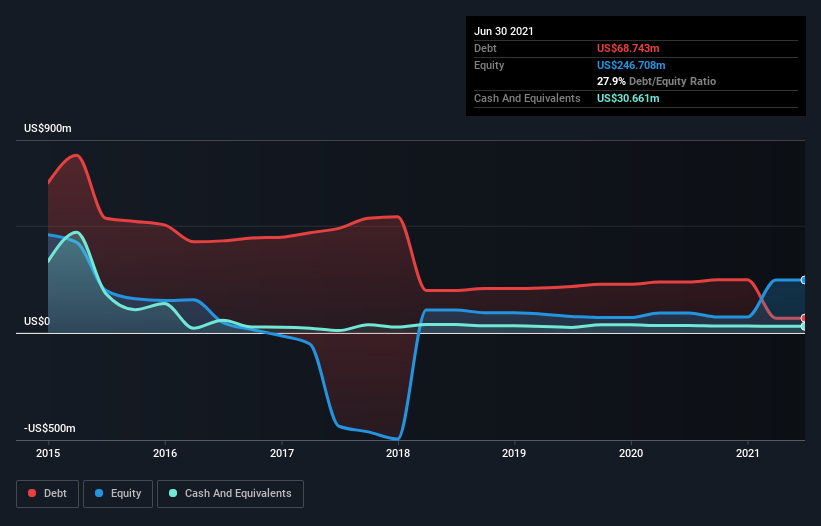Howard Marks put it nicely when he said that, rather than worrying about share price volatility, 'The possibility of permanent loss is the risk I worry about... and every practical investor I know worries about.' So it seems the smart money knows that debt - which is usually involved in bankruptcies - is a very important factor, when you assess how risky a company is. We can see that Paladin Energy Limited (ASX:PDN) does use debt in its business. But should shareholders be worried about its use of debt?
Why Does Debt Bring Risk?
Generally speaking, debt only becomes a real problem when a company can't easily pay it off, either by raising capital or with its own cash flow. If things get really bad, the lenders can take control of the business. However, a more common (but still painful) scenario is that it has to raise new equity capital at a low price, thus permanently diluting shareholders. By replacing dilution, though, debt can be an extremely good tool for businesses that need capital to invest in growth at high rates of return. When we think about a company's use of debt, we first look at cash and debt together.
Check out our latest analysis for Paladin Energy
How Much Debt Does Paladin Energy Carry?
As you can see below, Paladin Energy had US$68.7m of debt at June 2021, down from US$237.0m a year prior. However, because it has a cash reserve of US$30.7m, its net debt is less, at about US$38.1m.

How Healthy Is Paladin Energy's Balance Sheet?
Zooming in on the latest balance sheet data, we can see that Paladin Energy had liabilities of US$2.85m due within 12 months and liabilities of US$111.6m due beyond that. Offsetting this, it had US$30.7m in cash and US$1.98m in receivables that were due within 12 months. So it has liabilities totalling US$81.8m more than its cash and near-term receivables, combined.
Since publicly traded Paladin Energy shares are worth a total of US$1.98b, it seems unlikely that this level of liabilities would be a major threat. But there are sufficient liabilities that we would certainly recommend shareholders continue to monitor the balance sheet, going forward. When analysing debt levels, the balance sheet is the obvious place to start. But ultimately the future profitability of the business will decide if Paladin Energy can strengthen its balance sheet over time. So if you want to see what the professionals think, you might find this free report on analyst profit forecasts to be interesting.
While it hasn't made a profit, at least Paladin Energy booked its first revenue as a publicly listed company, in the last twelve months.
Caveat Emptor
Importantly, Paladin Energy had an earnings before interest and tax (EBIT) loss over the last year. Indeed, it lost US$27m at the EBIT level. When we look at that and recall the liabilities on its balance sheet, relative to cash, it seems unwise to us for the company to have any debt. So we think its balance sheet is a little strained, though not beyond repair. However, it doesn't help that it burned through US$6.7m of cash over the last year. So suffice it to say we do consider the stock to be risky. When analysing debt levels, the balance sheet is the obvious place to start. But ultimately, every company can contain risks that exist outside of the balance sheet. For example, we've discovered 4 warning signs for Paladin Energy (1 makes us a bit uncomfortable!) that you should be aware of before investing here.
At the end of the day, it's often better to focus on companies that are free from net debt. You can access our special list of such companies (all with a track record of profit growth). It's free.
New: Manage All Your Stock Portfolios in One Place
We've created the ultimate portfolio companion for stock investors, and it's free.
• Connect an unlimited number of Portfolios and see your total in one currency
• Be alerted to new Warning Signs or Risks via email or mobile
• Track the Fair Value of your stocks
This article by Simply Wall St is general in nature. We provide commentary based on historical data and analyst forecasts only using an unbiased methodology and our articles are not intended to be financial advice. It does not constitute a recommendation to buy or sell any stock, and does not take account of your objectives, or your financial situation. We aim to bring you long-term focused analysis driven by fundamental data. Note that our analysis may not factor in the latest price-sensitive company announcements or qualitative material. Simply Wall St has no position in any stocks mentioned.
Have feedback on this article? Concerned about the content? Get in touch with us directly. Alternatively, email editorial-team (at) simplywallst.com.
About ASX:PDN
Paladin Energy
Through its subsidiaries, engages in the development and exploration of mineral properties in Australia, Canada, and Namibia.
High growth potential with adequate balance sheet.
Similar Companies
Market Insights
Community Narratives




